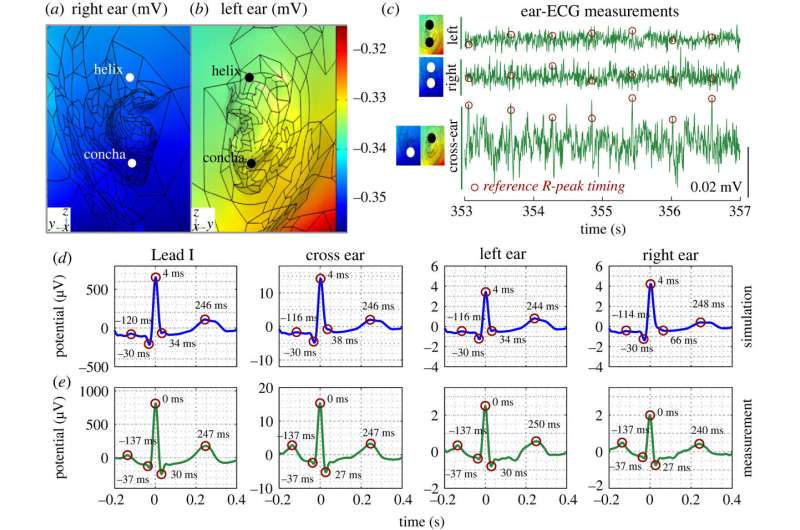This article has been reviewed according to Science X's editorial process and policies. Editors have highlighted the following attributes while ensuring the content's credibility:
fact-checked
peer-reviewed publication
trusted source
proofread
Research shows how a tiny device in the ear canal can monitor heart health

A driving simulation study has shown we are one step closer to monitoring our heart health in real time via a tiny device worn in the ear.
A study co-led by Ph.D. student Metin Yarici in Imperial's Department of Electrical and Electronic Engineering has shown for the first time how tiny devices in a single ear can gather electrocardiogram (ECG) data in real time.
The paper "Hearables: Feasibility of Recording Cardiac Rhythms from Single In-Ear Locations" was published in the journal Royal Society Open Science in January 2024.
Measuring cardiac health
Wearables that monitor our bodily functions—like smart watches—can give us an idea of our heartbeat but are not designed to accurately and unobtrusively measure the electrical current of the heart, which can diagnose an irregular heartbeat.
The team's previous research has identified the ear as a potential site from which to monitor both the brain function and our vital signs, via so-called hearable devices—a wearable that can snugly fit within the ear canal. They have also pioneered ear-ECG, where electrodes placed in both ears produce valid electrocardiograms.
However, the use of hearables to monitor cardiac health from a single ear is not currently well-proven. The Imperial team studied the ECG signals and mapped the chest-ECG potential over the ear, neck, and scalp regions. They then demonstrated the feasibility of single ear-ECG measurements under real-world recording conditions—a "driving simulation."
Participants' cardiac cycles were measured with electrodes on the ear region, confirming for the first time that the ECG signals from a single ear-ECG were accurate in shape and timing.
Metin Yarici, lead author of the study, said, "The significance of our findings lies in the high practicality and usability of the single ear-ECG. We believe that this method holds great promise in bringing continuous cardiac motoring out of a clinical setting and into society, and with it, new insights into heart functioning for healthy and patient populations alike. An important next step in this research is to test the feasibility of detecting specific abnormalities in heart function, such as atrial fibrillation or myocardial infarction, via the single ear-ECG."
The researchers say the technology could one day be used to monitor remotely, for example, patients and athletes, in a 24/7 continuous fashion, and to assess the effect of physical strain and stress in workplace environments.
Future applications
Senior author Professor Danilo Mandic, from the Department of Electrical and Electronic Engineering, said, "This is a pioneering way of taking an ECG from the ear canal to detect early signs of chronic heart problems, monitor heart condition and administer personalized delivery of medications. People will not have to feel ill before they go to their doctor as devices could pick up ECG data in real time. Our ear-ECG hearables can stream data wirelessly, and the system ties very well with the developments in AI and the push towards future eHealth.
"Earbuds can be put in easily and are very discreet, unobtrusive and non-stigmatizing, unlike electrodes worn on the scalp or neck.
"Our earbuds were granted a US patent in April 2023, and we hope these devices will be available to buy, and maybe even available through the NHS, shortly."
More information: Metin Yarici et al, Hearables: feasibility of recording cardiac rhythms from single in-ear locations, Royal Society Open Science (2024). DOI: 10.1098/rsos.221620





















